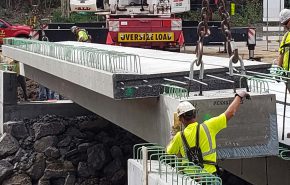While maneuvering highway construction work zones, drivers experience traffic tie-ups, delays, shifting traffic patterns, and more. This downtime translates to inefficiency, higher user costs, and major inconveniences, particularly in highly traveled urbanized areas. It also subjects our industry’s construction workers to long-term exposure to vehicular hazards.
Fortunately, the Federal Highway Administration (FHWA) and our Departments of Transportation (DOT) are seeking ways to save end-users money, promote construction efficiency, decrease carbon emissions, and increase work zone safety. These efforts have resulted in the progressive implementation of new and emerging construction methods and project delivery modes. One such method at the forefront of today’s transportation industry is Accelerated Bridge Construction (ABC), which has led to bridge replacement projects that significantly reduce facility downtime—in some cases from months to less than a week.
One such method at the forefront of today’s transportation industry is Accelerated Bridge Construction (ABC), which has led to bridge replacement projects that significantly reduce facility downtime—in some cases from months to less than a week.
Accelerated Bridge Construction Techniques and Methods—The Basics
To propagate this exciting project delivery method, the transportation industry has been educating design and construction professionals in the advancements of ABC techniques and lessons learned from the first generation of ABC projects. This method reduces the amount of construction time for bridge rehabilitations and replacements by using innovative ideas, materials, and methods. The majority of ABC occurs off site or off alignment—allowing traffic to move freely through the project limits until the bridge’s components are ready for installation. This prefabrication occurs in a staging area next to the bridge or in an off-site fabrication facility where construction is controlled and workers are safely located away from active traffic. Once the bridge components are fabricated and delivered to the site, installation is completed under short-term detour closures, generally in less than one week’s time.
Accelerated Bridge Construction Technology—Acceptance and Application
The FHWA is promoting ABC technology in its “Every Day Counts”—Better, Faster, Smarter initiative, resulting in DOTs across the country accepting and applying the method. Where obstacles once stood with certain proprietary materials, like those used in ultra-high performance concrete, they are now disappearing with the availability of domestically produced materials. Construction crews are gaining experience with ABC techniques and specialized equipment, bringing about increased interest in contractor bidding and narrowing the cost differential between ABC projects and conventional construction projects. The growing application of these materials will increase their widespread production and distribution, ultimately making them more cost effective.
Accelerated Bridge Construction Technology—Additional Upfront Investment Results in End-User Benefits
With additional implementation of ABC concepts, communities and transportation agencies will continue to develop an appreciation for the value of investing a modest premium in construction cost and accommodating an inconvenient short-term detour for other intrinsic benefits. Today’s ABC process can add value by reducing impacts to the economy, decreasing energy consumption, and lessening time lost in traffic compared with conventional multi-month construction projects. Many locations across the country have already recognized the benefits of a shorter roadway outage at an additional cost. This trend in the transportation industry will likely continue to gain popularity and achieve more widespread application in DOT construction projects in the future.
For questions or additional information about accelerated bridge construction, contact Director, Engineering/Transportation Ben Allis, PE at 412.476.2000.
![]() Ben serves as GAI’s Transportation Structures Market Sector Manager. He specializes in the design, analysis, construction engineering, and project management of structural transportation projects for both new and rehabilitated structures. He has provided services for an array of transportation clients, including departments of transportation, toll authorities, private authorities, and contractors.
Ben serves as GAI’s Transportation Structures Market Sector Manager. He specializes in the design, analysis, construction engineering, and project management of structural transportation projects for both new and rehabilitated structures. He has provided services for an array of transportation clients, including departments of transportation, toll authorities, private authorities, and contractors.
GAI recently completed work on an ABC project—the SR 600/US 92 Pedestrian Improvements Design-Build in Daytona Beach, FL. Check out the following articles to learn more about the pedestrian bridge, located over the International Speedway Boulevard:
SR 600/US 92 Pedestrian Improvements Wins FICE Award – May 12, 2016
Pedestrian Bridge Opens to Foot Traffic – Fast-Track Project Expected To Improve Safety – November 16, 2015


